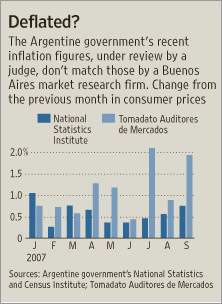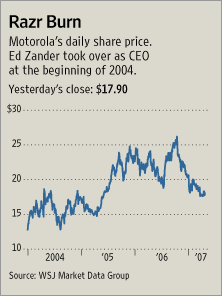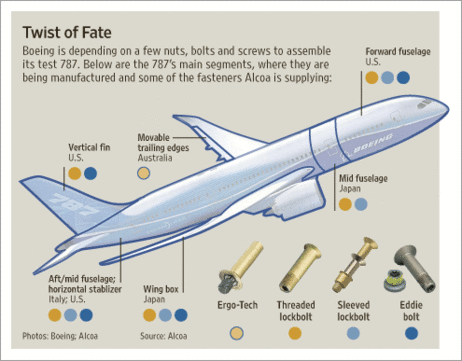 Source of graphic: online version of the WSJ article quoted and cited below.
Source of graphic: online version of the WSJ article quoted and cited below.
(p. A1) BUENOS AIRES — Argentina has had plenty of anti-inflation plans over the years. The current one may be the first that rests heavily on a public servant whom some executives and politicians have nicknamed "El Loco," or the Crazy Man.
The official, Guillermo Moreno, is Argentina’s Secretary of Internal Commerce, the government’s price policeman. His mission is limiting price markups in the red-hot economy — at least until the leftist Cristina Kirchner, the wife of the current president, Néstor Kirchner, can win her own bid for president. Elections are scheduled for this Sunday, and she’s heavily favored to win.
With the Kirchners’ blessing, Mr. Moreno has hammered out price-control agreements with industry, doled out subsidies and imposed export restrictions to keep the domestic market awash in goods. He has also threatened uncooperative businesses with prosecution under a recently resurrected 33-year law against hoarding goods. When none of that worked to restrain prices, a prosecutor has alleged, Mr. Moreno ousted the government statisticians who prepared the consumer price index and installed his own people to massage the numbers. Mr. Moreno denies that; a judge is reviewing the case.
. . .
(p. A18) As Argentina’s governing faction tries to prolong the country’s roaring economic recovery — and maintain its grip on power — it is waging an increasingly desperate battle to contain inflation. The government’s tainted figures put the annual figure at 8%, while most independent economists peg it around twice that high.
For the full story, see:
(Note: eillipsis added.)

 Sugar beats unloaded in Scottsbluff, Nebraska at Western Sugar in 1999. Source of photo: online version of the Omaha World-Herald article cited below.
Sugar beats unloaded in Scottsbluff, Nebraska at Western Sugar in 1999. Source of photo: online version of the Omaha World-Herald article cited below.
 Source of graph: online version of the WSJ article cited below.
Source of graph: online version of the WSJ article cited below. Motorola CEO. Source of image: online version of the WSJ article cited above.
Motorola CEO. Source of image: online version of the WSJ article cited above.
 Source of table: "World Publics Welcome Global Trade — But Not Immigration." Pew Global Attitudes Project, a project of the PewResearchCenter. Released: 10.04.07 dowloaded from:
Source of table: "World Publics Welcome Global Trade — But Not Immigration." Pew Global Attitudes Project, a project of the PewResearchCenter. Released: 10.04.07 dowloaded from: 
